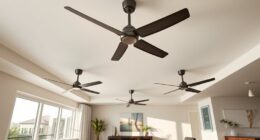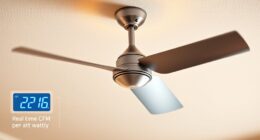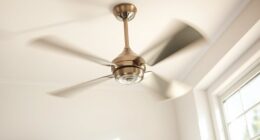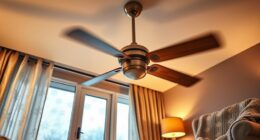Choosing the right ceiling fan size for your outdoor patio depends on the space's square footage. For areas up to 75 sq. ft., go for a fan with a 29-36 inch blade span. If your patio measures 76-144 sq. ft., a 36-42 inch blade span is ideal. For spaces 144-225 sq. ft., opt for a 44 inch fan. For larger patios, between 225-400 sq. ft., choose a fan with a 50-54 inch span or consider multiple fans. Proper sizing guarantees effective airflow and comfort. There's more to explore on fan types and features that could enhance your outdoor experience.
Key Takeaways
- For patios up to 75 sq. ft., choose a fan with a 29-36 inch blade span for optimal airflow.
- For areas between 76-144 sq. ft., a fan with a 36-42 inch blade span is recommended.
- Select a 44-inch blade span fan for spaces ranging from 144-225 sq. ft. to ensure effective cooling.
- For patios measuring 225-400 sq. ft., opt for a fan with a 50-54 inch blade span or install multiple fans.
- For areas over 400 sq. ft., consider extra-large fans (65 inches or more) or multiple fans to enhance air circulation.
Benefits of Outdoor Ceiling Fans

Outdoor ceiling fans are a game changer for your patio, offering numerous benefits that enhance your outdoor experience.
With effective air circulation, these fans can make your space feel 8-15° cooler, greatly improving your comfort during hot weather. You'll appreciate how they help deter flies and mosquitoes, ensuring a more enjoyable outdoor environment for your gatherings and relaxation.
One of the best aspects of outdoor ceiling fans is their affordability. Operating costs are typically low, making them an affordable cooling solution compared to traditional air conditioning systems. This means you can keep your patio comfortable without breaking the bank. Additionally, many outdoor ceiling fans are designed with high airflow capacity to ensure optimal cooling even in larger spaces. Moreover, using a sun-powered pool cover can complement your outdoor environment by reducing heat loss from nearby swimming pools.
Additionally, outdoor ceiling fans play an essential role in reducing moisture build-up on your patio slabs due to humidity. By keeping the air moving, they contribute to a more pleasant and dry outdoor environment, allowing you to fully enjoy your space. Regular maintenance, similar to that of air purifiers, can enhance their efficiency and longevity.
Choosing the right outdoor ceiling fan can elevate your outdoor living spaces, making them more inviting and comfortable for family and friends. Embrace the benefits of outdoor ceiling fans and transform your patio into a revitalizing retreat you'll love to use.
Calculating the Right Size

To find the right size ceiling fan for your outdoor patio, start by measuring the area's square footage.
You'll want to match your measurements with the appropriate blade span guidelines to guarantee effective air circulation.
This way, you can enjoy a comfortable and breezy outdoor experience.
Patio Area Measurement
Measuring your patio's square footage is essential for finding the right ceiling fan size. Start by multiplying the length and width of your outdoor space to get the total square footage. This patio area measurement guides you in selecting the perfect fan for effective airflow.
For areas up to 75 sq. ft., a fan with a blade span of 29-36 inches works well. If your patio measures between 76-144 sq. ft., look for an outdoor ceiling fan with a blade span of 36-42 inches. This guarantees that you'll enjoy adequate cooling during those hot days.
For larger patios ranging from 144-225 sq. ft., opt for a fan with a 44-inch blade span. If your outdoor space is even bigger, between 225-400 sq. ft., you'll need a fan with a 50-54 inch blade span. Alternatively, consider using multiple fans to achieve superior airflow.
Don't forget about your ceiling height, as it can also affect the performance of your chosen outdoor ceiling fan. By accurately measuring your patio, you'll guarantee that you select the ideal fan size for maximum comfort.
Blade Span Guidelines
Selecting the right blade span for your ceiling fan is essential for achieving ideal airflow on your patio.
For patios up to 75 square feet, a ceiling fan with a blade span of 29-36 inches will guarantee effective air circulation.
If your outdoor space is between 75-144 square feet, aim for a fan with a blade span of 36-42 inches for maximum airflow and cooling.
For areas measuring 144-225 square feet, a ceiling fan size of 44 inches is recommended to maintain comfort.
If your patio is larger, between 225-400 square feet, you'll want to choose a fan with a blade span of 50-54 inches. This size will help achieve sufficient air movement to keep you comfortable.
In very large open spaces exceeding 400 square feet, consider multiple outdoor patio fans or extra-large fans with a blade span of 65 inches or more for effective cooling.
Indoor vs. Outdoor Ceiling Fans

When choosing a ceiling fan for your patio, you need to contemplate the differences between indoor and outdoor models.
Indoor fans aren't built to handle moisture and weather conditions, which can lead to safety issues and damage.
On the other hand, outdoor fans are designed for durability and safety, ensuring they perform well in all outdoor elements.
Durability Against Elements
Choosing the right ceiling fan for your outdoor patio hinges on understanding the differences between indoor and outdoor models, particularly regarding their durability against the elements.
Indoor ceiling fans simply aren't built to withstand outdoor conditions, making them prone to moisture damage, rust, and premature failure.
On the other hand, outdoor ceiling fans are designed with weather-resistant materials and often have UL ratings for safety against electrical hazards.
When selecting an outdoor ceiling fan, consider these key factors:
- Damp Rated Outdoor Fans: Suitable for covered areas, these can handle moisture exposure but should avoid direct water contact.
- Wet Rated Fans: These are fully sealed to resist intense moisture, making them ideal for patios and pergolas that might experience rain or snow.
- Avoid Indoor Fans Outdoors: Using an indoor fan outdoors can't only lead to damage and safety hazards but can also void your warranty.
Safety Considerations
Understanding the differences in safety features between indoor and outdoor ceiling fans is essential for your outdoor space. Indoor fans aren't designed for outdoor use and lack moisture resistance, which can lead to significant safety hazards.
Using an indoor fan outside can expose you to electrical hazards, as these fans can suffer from water damage and may void warranties.
When selecting outdoor fans, you'll encounter two primary categories: damp rated and wet rated fans. Damp rated fans can handle some moisture but should only be installed in covered areas like patios or porches to avoid direct water exposure.
On the other hand, wet rated fans are designed to endure intense moisture and are suitable for uncovered areas exposed to rain or snow.
Choosing the right fan is vital to ensuring safety in your outdoor space. By opting for damp or wet rated fans, you minimize the risks associated with moisture and electrical hazards, providing peace of mind while enjoying your patio.
Always remember to follow manufacturer guidelines to maintain safety and performance in your outdoor environment.
Performance Differences
The performance differences between indoor and outdoor ceiling fans really stand out when you consider their designs and intended environments.
Outdoor ceiling fans are specifically engineered to handle moisture, with ratings like damp or wet, ensuring they can endure the elements. In contrast, indoor fans aren't built for such conditions, which can lead to costly damage and maintenance.
Here are three key performance differences to keep in mind:
- Moisture Resistance: Wet rated ceiling fans can withstand direct rain and snow, while damp rated fans are best for sheltered areas. Indoor fans lack this protection entirely.
- Safety Standards: Outdoor fans are UL rated to protect against electrical hazards from water exposure, a concern not applicable to indoor models.
- Longevity: Indoor and outdoor ceiling fans differ markedly in durability. Using an indoor fan for your outdoor space can void warranties due to improper use.
When choosing the right fan size for your outdoor area, remember that outdoor ceiling fans provide maximum cooling while ensuring safety and reliability.
Don't compromise; choose the right fan for your outdoor space!
Types of Outdoor Ceiling Fans

When it comes to outdoor ceiling fans, you'll find several types tailored to different environments and needs.
For uncovered areas like patios and pergolas, wet rated fans are your best bet, as they're designed for direct exposure to rain and moisture.
If you have a covered space, such as a porch, damp rated fans will work well since they can handle some moisture without being directly exposed.
If you want to enhance the functionality of your outdoor area, consider fans with integrated lighting fixtures.
These fans provide both airflow and illumination, making them perfect for evening gatherings.
For those living in coastal areas, corrosion-resistant outdoor fans are essential, as they withstand the harsh effects of saltwater and humidity.
For added convenience, remote-controlled outdoor fans let you adjust settings without needing to walk over to a wall switch.
This feature enhances your overall experience, allowing you to enjoy your outdoor space with ease.
Fan Placement and Spacing
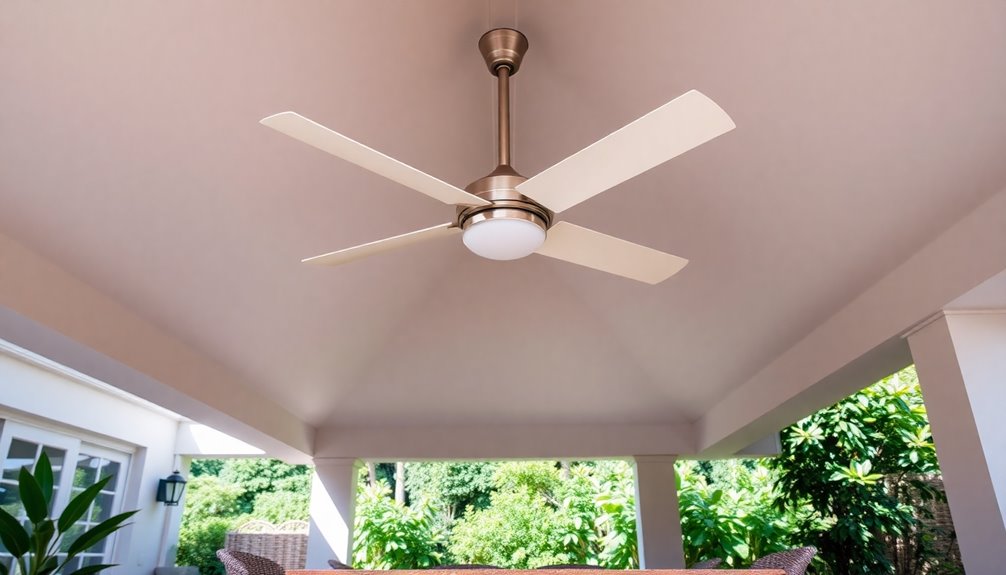
Proper fan placement and spacing are essential for creating a comfortable outdoor environment. To maximize airflow and cooling effectiveness on your patio, follow these guidelines:
- Maintain Distance: Keep your ceiling fan at least 1.5 times its diameter away from walls. This guarantees effective circulation and prevents airflow obstruction.
- Spacing Between Fans: If you're using multiple fans, space them by multiplying the fan diameter by 3. This will provide adequate coverage and guarantee air movement across the entire patio area.
- Mount Height: Install ceiling fans at least 7 feet above the ground. This height not only assures safety but also maximizes airflow efficiency.
For low ceilings, consider flush-mount fans, while downrod fans are ideal for ceilings 8 feet and higher.
In larger outdoor spaces, staggered layouts with multiple fans can greatly improve overall cooling effectiveness.
Energy Efficiency Considerations

Choosing an energy-efficient outdoor ceiling fan can greatly impact your comfort and utility bills, especially during those hot summer months. Energy-efficient outdoor ceiling fans can be up to 64% more efficient than conventional fans, markedly reducing your electricity costs over time.
When selecting a fan, look for an ENERGY STAR® certified fan to guarantee peak performance while minimizing energy consumption.
Larger fans with a higher blade span typically move more air at lower speeds, enhancing energy efficiency by lessening the demand for higher motor speeds. This not only cools your space effectively but also contributes to energy savings.
Additionally, consider fans equipped with LED lighting options. These lights provide ample illumination while using less energy due to their longer lifespan and lower energy usage.
Proper sizing of your outdoor ceiling fan is essential for achieving peak airflow. A correctly sized fan operates efficiently, cooling your patio without excessive energy waste.
Frequently Asked Questions
How Big of Fan for Outdoor Patio?
When you're deciding how big of a fan to use for your outdoor patio, consider the size of your space.
For areas up to 75 sq. ft., a fan with a 29-36 inch blade span works well.
If your patio is between 76-144 sq. ft., opt for a 36-42 inch blade span.
For larger areas, you'll need a 44-inch fan for 144-225 sq. ft. and a 50-54 inch fan for 225-400 sq. ft.
What Type of Fan Is Best for an Outdoor Patio?
Did you know that a ceiling fan can lower your perceived temperature by up to 10 degrees?
When choosing a fan for your outdoor patio, look for wet-rated or damp-rated models to withstand moisture.
Opt for energy-efficient motors and multiple speeds for comfort and cost savings.
If you're in a coastal area, pick corrosion-resistant materials for durability.
This way, you'll enjoy your outdoor space while keeping cool and stylish!
How Many Blades Are Best for an Outdoor Ceiling Fan?
When choosing the number of blades for your outdoor ceiling fan, it depends on your preferences.
If you want higher airflow and energy efficiency, a 3-blade fan might be your best bet.
However, if you're after quieter operation and a smoother airflow, consider a 5-blade fan.
Ultimately, think about the aesthetics and noise levels in your outdoor space; both options can effectively cool your area, but your comfort is key.
Do You Need a Special Ceiling Fan for Outdoor?
When it comes to outdoor spaces, you definitely want to choose a fan that can brave the elements.
You can't just grab any old indoor fan; they aren't built for the great outdoors. Instead, opt for fans rated for wet or damp conditions.
These specially designed fans will keep your area cool and safe, ensuring you enjoy your outdoor oasis without a worry.
Conclusion
In the end, choosing the right size ceiling fan for your outdoor patio can transform your space into a breezy retreat, much like a scene from a summer blockbuster. By considering the benefits, calculating dimensions, and picking the right type, you'll create a comfortable oasis that keeps you cool on hot days. With proper placement and energy efficiency in mind, you'll be ready to enjoy those warm evenings under the stars, reminiscent of balmy nights in paradise.






